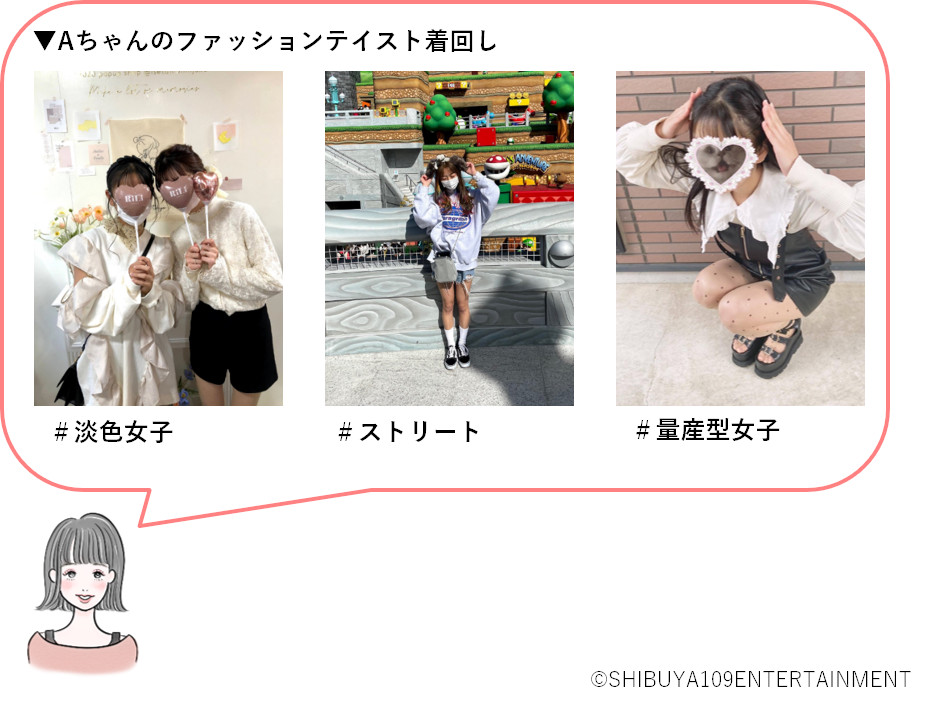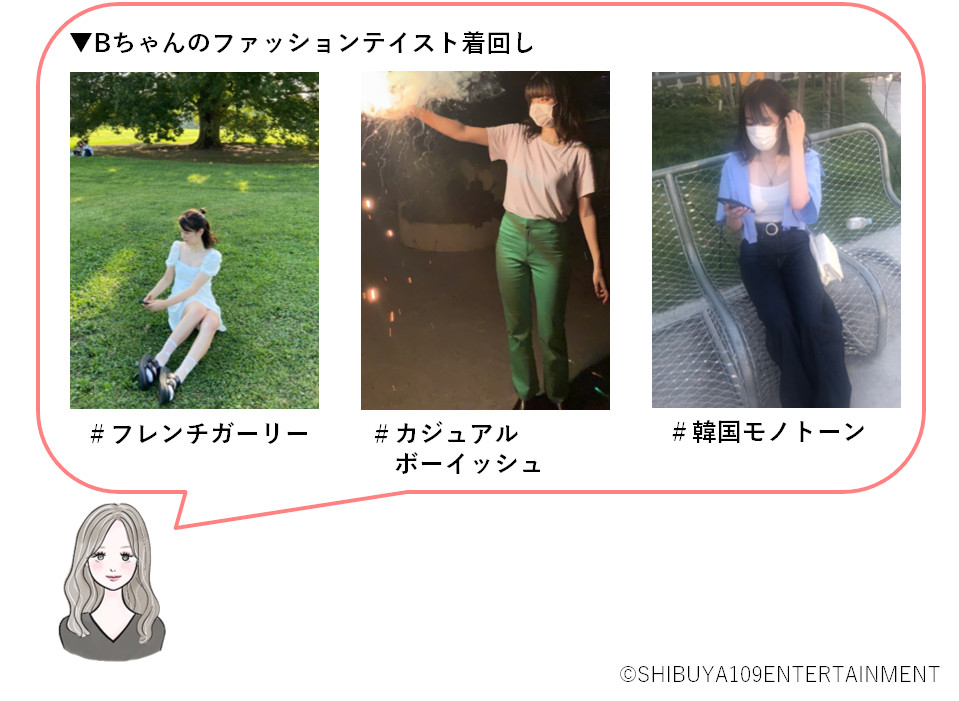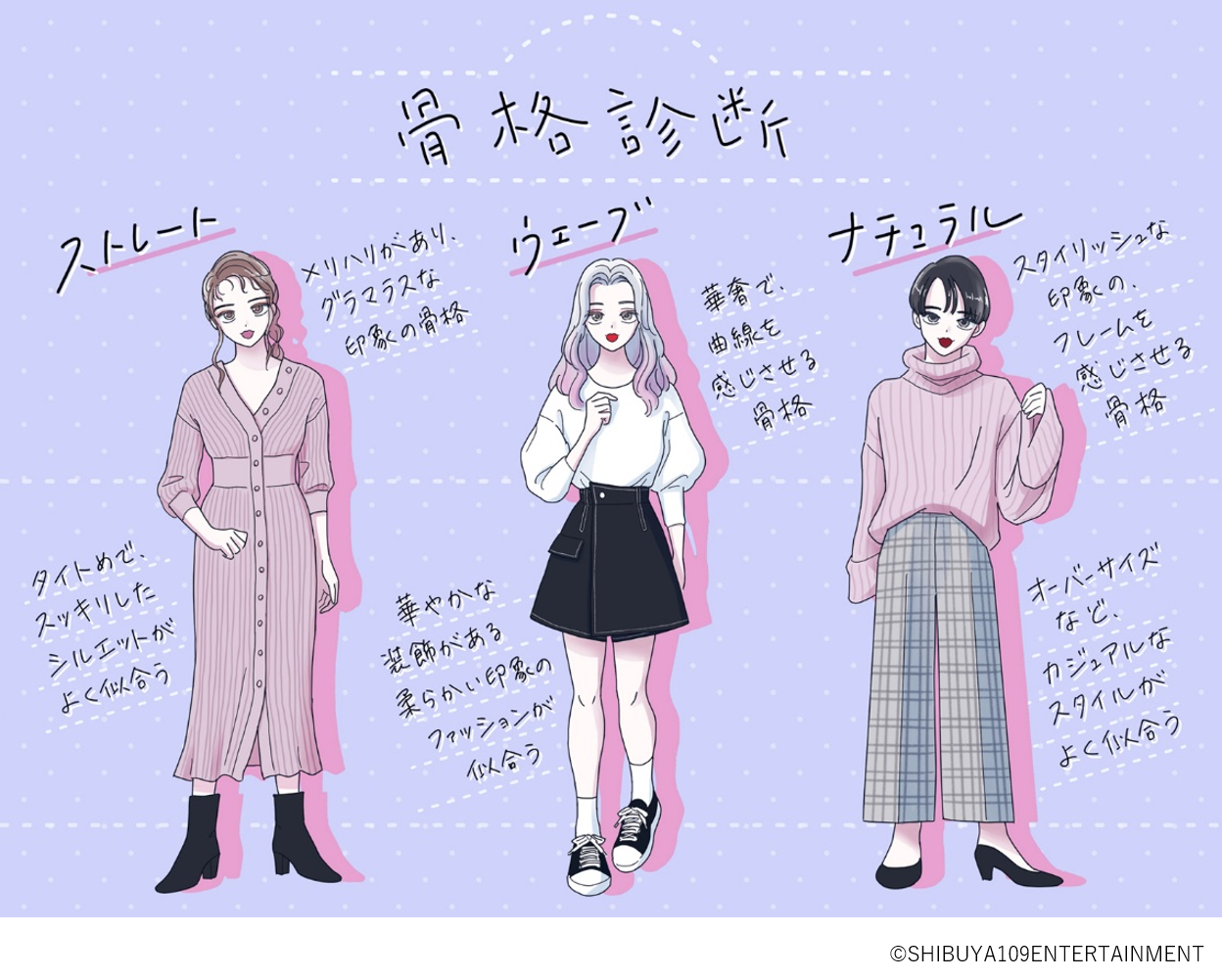
Brands are out, coordinating how you look with what you’re doing is in.
A recent survey by Shibuya 109 Lab, a youth marketing research company associated with the Tokyo fashion shopping center of the same name, recently asked 205 people in Generation Z about their fashion choices.
85 young men and 120 young women between ages 15 and 24 who are affiliated with Shibuya 109 Lab’s independent network were surveyed, starting with the question, “When you go out, how do you decide what to wear?”
Interestingly, most respondents seemed to carefully coordinate their outfits according to their plans for the day. The top answer of all respondents was “I choose according to where I am going” (67.3 percent). Close behind was “I choose according to what I’m doing” (53.7 percent).
▼ Here are the fashions sported by A-chan, who prefers “Light-color girl” style, “Street” style, and “Mass-production girl” style.
30.7 percent even said they plan their outfit according to who they’re hanging out with, meaning they align their fashion with their companions’ fashion tastes.
One female respondent said: “When we wear similar clothes, it looks like we’re really good friends. Plus, it creates a sense of unity in photos when what we’re wearing matches the place we’re going.”
Next, the respondents were asked about their own fashion tastes, with the option to choose multiple responses.
For men, far and away the most popular fashion style was “Casual” (58.8 percent), followed by “Clean and Sophisticated” (24.7 percent). Close behind in third place was “Street” style, which earned 22.4 percent of the vote.
While the men seemed to have a majority preference for casual clothing, women’s responses were more evenly divided. The top fashion style for young women was “Casual Girly” (30 percent), followed by “Casual Boyish” (27.5 percent), and “Clean and sophisticated” (25 percent).
▼ B-chan prefers “French girly”, “Casual boyish”, and “Korean monotone” styles.
What was surprising, though, was that for both young men and young women, a good proportion of respondents selected three or more styles that represented their personal tastes. 28.2 percent of men and 44.2 percent of women seem to rotate between various different fashion styles, indicating they don’t subscribe to one particular trend.
When asked to rate how well the statement “I choose fashion based on taste, not on brands” applied to them, out of all respondents, 28.3 percent said “Very accurate”, and 42.9 percent said “Somewhat accurate”, meaning that, in total, 71.2 percent agreed that they don’t factor brands into their fashion choices as much as the style of the clothes.
One female college student said: “I like Korean fashion so I wear a lot of Korean-style clothes, but I shop online so I don’t remember what brands I buy.”
A male college student said: “I don’t really have a favorite brand, though I do shop at GU and Uniqlo a lot. I also buy from Zozotown, but I don’t know what brands.”
▼ C-kun, who likes to rotate between “Casual”, “Sharp”, and “Korean Monotone” fashion styles.
If not brands, then what are respondents looking for when shopping for clothes?
In response to the question, “What do you focus on when shopping for clothes?”, 63.9 percent chose “The design”, 55.1 percent said, “The fit”, and 44.9 chose “How well I can mix and match it”.
Multiple participants mentioned a social media “Body Type Diagnosis”, which they used to determine their build and which clothes and fashion styles would suit them best.
▼ The “Body Type Diagnosis” includes the “Straight” type, the “Wave” type, and the “Natural” type, which each have different styles that suit them.
All of this is meant to provide them with the best clothes so that, when taking full-body photos to share on social media, they’ll look the best they can.
Social media is also the number one way that these young people get information about fashion. 83.4 percent said they get most of their fashion news from Instagram, 40.5 percent said “Video streaming services”, and 33.7 percent said “TikTok.” “From family and friends” was another popular response, tying with “video streaming services” at 40.5 percent.
The major takeaway from this survey is that fashion for Generation Z in Japan is becoming less a tool for self-expression, and rather more a tool for communication, such as, for example, using a coordinated look to say “Look how close we are!”
While of course there are many influences on their choices, such as the popularity of Korean fashion, it seems that Japanese young people are less concerned about following a particular style or buying a particular brand and more concerned about finding fashions that suit them so they will look good on social media. As social media continues to be a prevalent influence on young people’s personal identities, we can only wonder how they’ll affect the next generation’s fashion choices, too.
Source: PR Times, Shibuya 109 Lab via Netlab
Images: PR Times
● Want to hear about SoraNews24’s latest articles as soon as they’re published? Follow us on Facebook and Twitter!





 Survey asks which country’s fashion is the most influential in Japanese street style
Survey asks which country’s fashion is the most influential in Japanese street style Do most Japanese Gen Z music lovers skip the guitar solo in songs? Survey finds out
Do most Japanese Gen Z music lovers skip the guitar solo in songs? Survey finds out Survey reveals Uniqlo’s most popular winter clothing beats its peers by a fair margin
Survey reveals Uniqlo’s most popular winter clothing beats its peers by a fair margin Locked and blocked! Japanese people don’t trust others on social media, survey finds
Locked and blocked! Japanese people don’t trust others on social media, survey finds Japanese men reveal their favorite women’s lingerie colors in survey
Japanese men reveal their favorite women’s lingerie colors in survey Rakuten randomly offers 58 New Year’s osechi feasts in Japan, but did we get a star or a dud?
Rakuten randomly offers 58 New Year’s osechi feasts in Japan, but did we get a star or a dud? Japanese beef bowl chain Sukiya’s 2026 Smile Box lucky bag basically pays for itself
Japanese beef bowl chain Sukiya’s 2026 Smile Box lucky bag basically pays for itself Majority of Japanese mayors say foreign residents are essential but most see good and bad effects
Majority of Japanese mayors say foreign residents are essential but most see good and bad effects Four Shinto shrines to pray for love at in Japan to start the New Year
Four Shinto shrines to pray for love at in Japan to start the New Year Tokyo fish market breaks New Year auction record as single fish sells for over 5 million yen【Vid】
Tokyo fish market breaks New Year auction record as single fish sells for over 5 million yen【Vid】 Should you dip your cake in sake? One Japanese brewer says no, but actually yes【 Taste test】
Should you dip your cake in sake? One Japanese brewer says no, but actually yes【 Taste test】 Japan’s laziest, least motivated train station ticket gate charms the Internet【Photos】
Japan’s laziest, least motivated train station ticket gate charms the Internet【Photos】 New Japanese menstrual product seeks to help women spot unidentified iron deficiencies
New Japanese menstrual product seeks to help women spot unidentified iron deficiencies We delight in the gastronomic treasures we found in the Hokkaido Umaimonokan lucky bag
We delight in the gastronomic treasures we found in the Hokkaido Umaimonokan lucky bag Survey says osechi New Year’s food differs according to each region in Japan
Survey says osechi New Year’s food differs according to each region in Japan Starbucks Japan ready to get Year of the Horse started with adorable drinkware and plushies【Pics】
Starbucks Japan ready to get Year of the Horse started with adorable drinkware and plushies【Pics】 Hayao Miyazaki says Happy New Year to Studio Ghibli fans with new art for Year of the Horse
Hayao Miyazaki says Happy New Year to Studio Ghibli fans with new art for Year of the Horse We found possibly the quietest Japanese-style hotel in Tokyo’s bustling Shinjuku district
We found possibly the quietest Japanese-style hotel in Tokyo’s bustling Shinjuku district Cup Noodle tries an authentic Jiro-style ramen, but something’s not quite right
Cup Noodle tries an authentic Jiro-style ramen, but something’s not quite right The best Starbucks Japan Frappuccinos we want to drink again in 2026
The best Starbucks Japan Frappuccinos we want to drink again in 2026 We revisited Sweets Paradise after a decade to see if Japan’s dessert buffet still delivers
We revisited Sweets Paradise after a decade to see if Japan’s dessert buffet still delivers That time Seiji called JASRAC to ask why he didn’t get paid royalties for his song being on TV
That time Seiji called JASRAC to ask why he didn’t get paid royalties for his song being on TV Japan’s oldest largetooth sawfish in captivity back on display in Mie Prefecture
Japan’s oldest largetooth sawfish in captivity back on display in Mie Prefecture Pizza Hut Japan’s hot lucky bags are perfect for a New Year’s pizza party
Pizza Hut Japan’s hot lucky bags are perfect for a New Year’s pizza party 7-Eleven Japan starts new temporary luggage storage service in over 300 branches
7-Eleven Japan starts new temporary luggage storage service in over 300 branches Disillusionment at Tsukiji’s tourist-target prices led us to a great ramen restaurant in Tokyo
Disillusionment at Tsukiji’s tourist-target prices led us to a great ramen restaurant in Tokyo Starbucks teams up with 166-year-old Kyoto doll maker for Year of the Horse decorations【Photos】
Starbucks teams up with 166-year-old Kyoto doll maker for Year of the Horse decorations【Photos】 Tokyo considering law requiring more trash cans following litter increase in heavily touristed area
Tokyo considering law requiring more trash cans following litter increase in heavily touristed area Tokyo’s Tsukiji sushi neighborhood asks tour groups to stay away for the rest of the month
Tokyo’s Tsukiji sushi neighborhood asks tour groups to stay away for the rest of the month Tokyo event lets you travel back in time, for free, to celebrate 100 years since Showa era start
Tokyo event lets you travel back in time, for free, to celebrate 100 years since Showa era start Japan may add Japanese language proficiency, lifestyle classes to permanent foreign resident requirements
Japan may add Japanese language proficiency, lifestyle classes to permanent foreign resident requirements Sanrio theme park in Japan announces plans to expand into a Sanrio resort
Sanrio theme park in Japan announces plans to expand into a Sanrio resort Stamina-destroying “Paralysis Noodles” are Tokyo’s newest over-the-top ramen innovation
Stamina-destroying “Paralysis Noodles” are Tokyo’s newest over-the-top ramen innovation Survey asks foreign tourists what bothered them in Japan, more than half gave same answer
Survey asks foreign tourists what bothered them in Japan, more than half gave same answer Japan’s human washing machines will go on sale to general public, demos to be held in Tokyo
Japan’s human washing machines will go on sale to general public, demos to be held in Tokyo Japan’s deadliest food claims more victims, but why do people keep eating it for New Year’s?
Japan’s deadliest food claims more victims, but why do people keep eating it for New Year’s? We deeply regret going into this tunnel on our walk in the mountains of Japan
We deeply regret going into this tunnel on our walk in the mountains of Japan Studio Ghibli releases Kodama forest spirits from Princess Mononoke to light up your home
Studio Ghibli releases Kodama forest spirits from Princess Mononoke to light up your home Major Japanese hotel chain says reservations via overseas booking sites may not be valid
Major Japanese hotel chain says reservations via overseas booking sites may not be valid Put sesame oil in your coffee? Japanese maker says it’s the best way to start your day【Taste test】
Put sesame oil in your coffee? Japanese maker says it’s the best way to start your day【Taste test】 No more using real katana for tourism activities, Japan’s National Police Agency says
No more using real katana for tourism activities, Japan’s National Police Agency says Starbucks Japan reveals new sakura drinkware collection, inspired by evening cherry blossoms
Starbucks Japan reveals new sakura drinkware collection, inspired by evening cherry blossoms Updated cherry blossom forecast shows extra-long sakura season for Japan this year
Updated cherry blossom forecast shows extra-long sakura season for Japan this year Nearly 70 percent of young Japanese women self-identify as otaku in survey
Nearly 70 percent of young Japanese women self-identify as otaku in survey Improve your summer dating knowledge with these Japanese dating app survey results
Improve your summer dating knowledge with these Japanese dating app survey results Survey reveals that many young people in Japan are experiencing loneliness and isolation
Survey reveals that many young people in Japan are experiencing loneliness and isolation What will 2021 mean for Valentine’s Day in Japan? Survey asks teens their chocolate plans
What will 2021 mean for Valentine’s Day in Japan? Survey asks teens their chocolate plans Roughly 40 percent of single Japanese men in their 20s have never been on a date, survey says
Roughly 40 percent of single Japanese men in their 20s have never been on a date, survey says Futago koude: The hot new fashion trend of Japanese women dressing like twins
Futago koude: The hot new fashion trend of Japanese women dressing like twins Japan’s Newest Fashion Trend: Dressing Like a Zen Priest?
Japan’s Newest Fashion Trend: Dressing Like a Zen Priest? “Which hairstyle makes a woman look good at her job?” asks Japanese survey
“Which hairstyle makes a woman look good at her job?” asks Japanese survey How many people in Japan have actually worn a couple’s outfit?
How many people in Japan have actually worn a couple’s outfit? Forever 21 returns to Japan with limited time pop-up event, online store also open
Forever 21 returns to Japan with limited time pop-up event, online store also open Most of Japan’s new adults hope to fall in love and get married, according to recent survey
Most of Japan’s new adults hope to fall in love and get married, according to recent survey Do Japanese women check out each other’s lingerie at the hot springs? Survey investigates
Do Japanese women check out each other’s lingerie at the hot springs? Survey investigates Is it OK to split the bill on a date in Japan? Survey asks what women and men of different ages think
Is it OK to split the bill on a date in Japan? Survey asks what women and men of different ages think Frills and poofy dresses galore at an international lolita fashion tea party in Tokyo
Frills and poofy dresses galore at an international lolita fashion tea party in Tokyo Japanese women asked what they would do if they had a man’s body for one day in survey
Japanese women asked what they would do if they had a man’s body for one day in survey
Leave a Reply